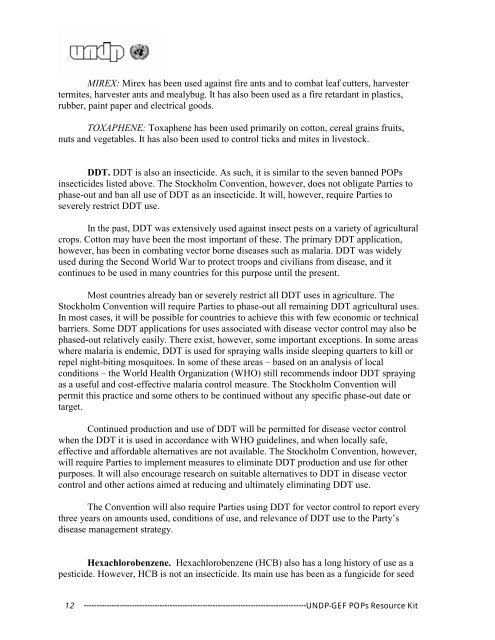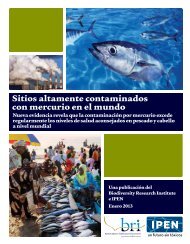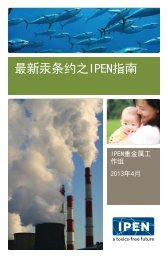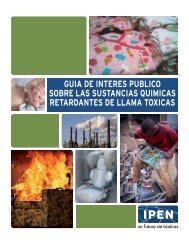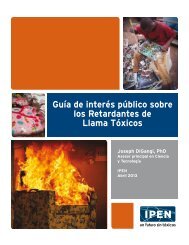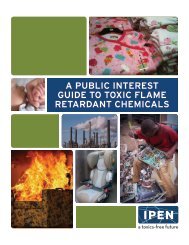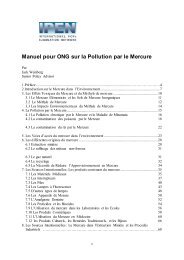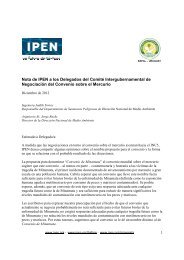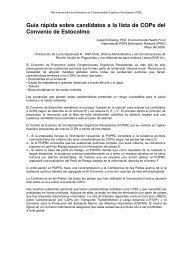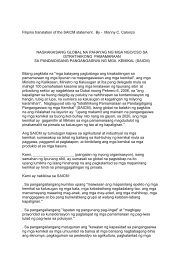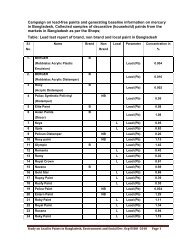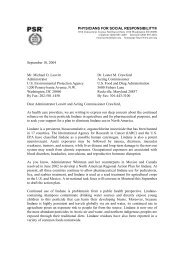The UNDP-GEF POPs Resource Kit - International POPs Elimination ...
The UNDP-GEF POPs Resource Kit - International POPs Elimination ...
The UNDP-GEF POPs Resource Kit - International POPs Elimination ...
You also want an ePaper? Increase the reach of your titles
YUMPU automatically turns print PDFs into web optimized ePapers that Google loves.
MIREX: Mirex has been used against fire ants and to combat leaf cutters, harvester<br />
termites, harvester ants and mealybug. It has also been used as a fire retardant in plastics,<br />
rubber, paint paper and electrical goods.<br />
TOXAPHENE: Toxaphene has been used primarily on cotton, cereal grains fruits,<br />
nuts and vegetables. It has also been used to control ticks and mites in livestock.<br />
DDT. DDT is also an insecticide. As such, it is similar to the seven banned <strong>POPs</strong><br />
insecticides listed above. <strong>The</strong> Stockholm Convention, however, does not obligate Parties to<br />
phase-out and ban all use of DDT as an insecticide. It will, however, require Parties to<br />
severely restrict DDT use.<br />
In the past, DDT was extensively used against insect pests on a variety of agricultural<br />
crops. Cotton may have been the most important of these. <strong>The</strong> primary DDT application,<br />
however, has been in combating vector borne diseases such as malaria. DDT was widely<br />
used during the Second World War to protect troops and civilians from disease, and it<br />
continues to be used in many countries for this purpose until the present.<br />
Most countries already ban or severely restrict all DDT uses in agriculture. <strong>The</strong><br />
Stockholm Convention will require Parties to phase-out all remaining DDT agricultural uses.<br />
In most cases, it will be possible for countries to achieve this with few economic or technical<br />
barriers. Some DDT applications for uses associated with disease vector control may also be<br />
phased-out relatively easily. <strong>The</strong>re exist, however, some important exceptions. In some areas<br />
where malaria is endemic, DDT is used for spraying walls inside sleeping quarters to kill or<br />
repel night-biting mosquitoes. In some of these areas – based on an analysis of local<br />
conditions – the World Health Organization (WHO) still recommends indoor DDT spraying<br />
as a useful and cost-effective malaria control measure. <strong>The</strong> Stockholm Convention will<br />
permit this practice and some others to be continued without any specific phase-out date or<br />
target.<br />
Continued production and use of DDT will be permitted for disease vector control<br />
when the DDT it is used in accordance with WHO guidelines, and when locally safe,<br />
effective and affordable alternatives are not available. <strong>The</strong> Stockholm Convention, however,<br />
will require Parties to implement measures to eliminate DDT production and use for other<br />
purposes. It will also encourage research on suitable alternatives to DDT in disease vector<br />
control and other actions aimed at reducing and ultimately eliminating DDT use.<br />
<strong>The</strong> Convention will also require Parties using DDT for vector control to report every<br />
three years on amounts used, conditions of use, and relevance of DDT use to the Party’s<br />
disease management strategy.<br />
Hexachlorobenzene. Hexachlorobenzene (HCB) also has a long history of use as a<br />
pesticide. However, HCB is not an insecticide. Its main use has been as a fungicide for seed<br />
12 ----------------------------------------------------------------------------------------<strong>UNDP</strong>-<strong>GEF</strong> <strong>POPs</strong> <strong>Resource</strong> <strong>Kit</strong>


